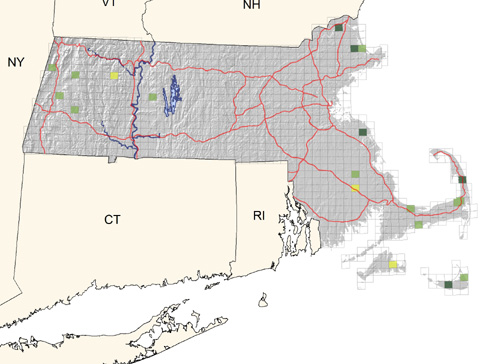Find a Bird - BBA1
Breeding Bird Atlas 1 Species Accounts
Northern Saw-whet Owl
Aegolius acadicus
Egg Dates
late March to July 3
Number of Broods
one; may re-lay if first attempt fails.

Although the Northern Saw-whet Owl is widely distributed, it is seldom seen because of its diminutive size (it is the smallest of the eastern owls) and strictly nocturnal behavior. It is undoubtedly more common than the records would indicate. During the Atlas period, breeding was confirmed only in scattered blocks in eastern Massachusetts, from Essex County and Plymouth County to Cape Cod and Nantucket. The species went unrecorded in most blocks in the interior sections of the state, but it is known to inhabit some of these areas, including northern Worcester County and portions of Franklin County.
This bird’s vernacular name derives from one of its calls, a two-syllable vocalization likened to the sound of a file sharpening a large saw. This call is seldom given. Saw-whet owls are most vocal just prior to and early in the breeding season (from mid-March to mid-April) and can be heard at dusk, dawn, and varying intervals throughout the night. At this time, the most commonly recorded call is a short, sweet whistle or toot, repeated endlessly 100 or more times a minute. Other vocalizations include a thrushlike, staccato whistle and various gasps and clacks. Outside this brief period of vocal activity, these owls generally are silent.
The saw-whet owl shows a preference for deep, swampy woodlands, usually in areas of conifers. Its nest is typically in an old woodpecker hole, often that of a flicker. Sometimes a natural cavity is used. The nest is generally unlined, but if there is nesting material present it is most likely left over from a previous avian or mammalian occupant. Locations of 6 Massachusetts nests were as follows: 3 in pine stubs, 1 in a Sycamore stub, 1 in a dead American Chestnut, 1 in a natural hole in an Atlantic White Cedar, and 1 in a natural crevice in a maple stub. Three of the first four cavities were reported to be old flicker holes. Heights ranged from 7 to 25 feet (ACB, Grice 1942, Petersen).
The four to seven eggs are laid at 1- to 3-day intervals, with the young hatching at similar periods and thus varying in size. Clutch sizes for 5 state nests were four eggs (1 nest), five eggs (1 nest), six eggs (2 nests), seven eggs (1 nest) (ACB, Grice 1942). Incubation is reported as taking 21 to 28 days, probably closer to the higher number. The white down of the chicks is replaced with the rich, dark mahogany feathers of the juvenal plumage during the second to fourth week. The young leave the nest at 27 to 34 days of age. Nestlings have been observed in Massachusetts from May 3 to June 15 (Grice 1942, TC, Olmstead). The single nestling was discovered in Templeton, providing a post-Atlas confirmation for Worcester County (TC). Young typically fledge during May and June. One brood is raised each season, but the birds may renest if they have lost their first clutch. Three of seven eggs in a Wareham nest were ready to hatch on July 3 (ACB). This indicates that late dates for both nestlings and fledglings can occasionally be expected.
The food of the saw-whet owl consists mainly of woodland mice such as Deer Mice, White-footed Mice, and Red-backed Voles. Other prey includes small rats, Red Squirrels, flying squirrels, Eastern Chipmunks, shrews, bats, insects, and small birds.
Though the saw-whet owl is considered to be a resident in Massachusetts, there is evidence that some migration occurs, or at least that the birds may wander widely in the fall. Much of this movement involves a shifting within the extensive breeding range, and it occurs primarily from October through December. There is also evidence of a return from March to May. In severe winters, birds from farther north may appear. During the winter, individuals may show up at a variety of locations where they had not previously occurred, usually roosting in conifers. At such times, the birds are reluctant to flush and are quite approachable, a behavior that has led some authors to describe them as fearless, tame, or even stupid. Sometimes numbers of saw-whet owls have been found dead during the winter months. These could either be resident birds unable to find food because of snow cover or wanderers from the north too emaciated to find prey.
Map Legend and Data Summary
Atlas 1 data collected from 1975-1979


Note: rare and local in Berkshire County; also along the coast, especially on Cape Cod and the Islands; undoubtedly overlooked elsewhere
Mark C. Lynch



